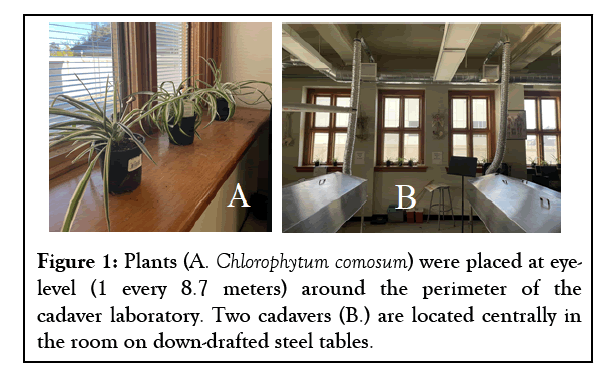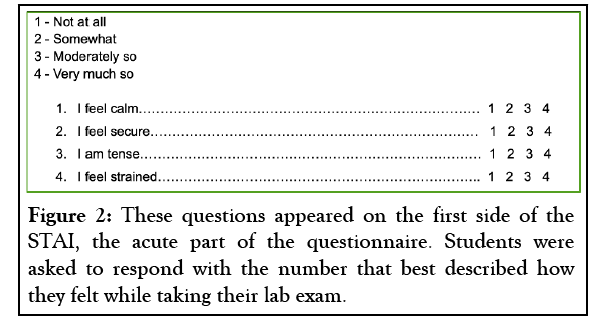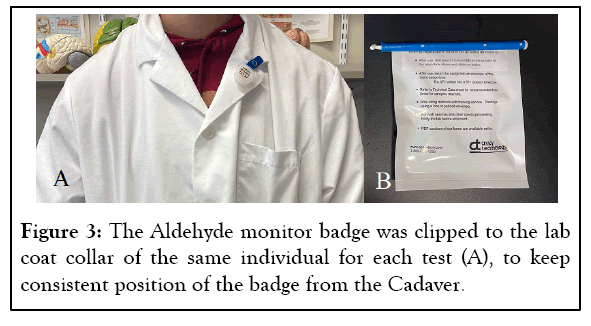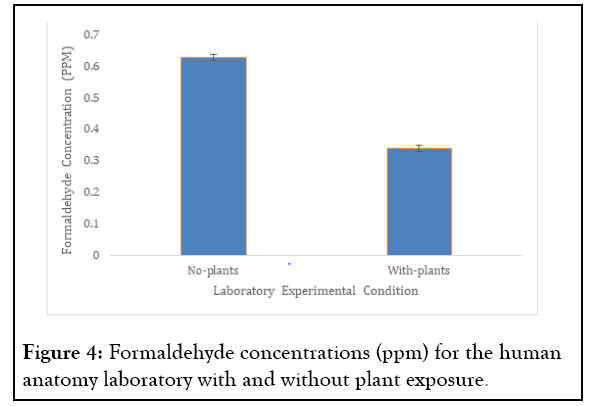Anatomy & Physiology: Current Research
Open Access
ISSN: 2161-0940
ISSN: 2161-0940
Research Article - (2023)Volume 13, Issue 2
Exposure to plants has been shown to remove specific airborne pollutants and carcinogens, reduce stress and improve productivity in the workplace. This study investigates the effect of plant exposure on air quality, student anxiety (STAI) and performance test scores in a cadaver laboratory at a small liberal arts college. Undergraduate Human Anatomy students were randomly assigned plant and control (no-plant) exposure in the human cadaver laboratory. Air quality marked improvements with reductions of nearly half the total Short Term Exposure Limits (15-Minute STEL) to formaldehyde (p < 0.01). No significant differences between plant exposure or laboratory sections were detected for Acute STAI (P=0.35), General STAI (P=0.71) or for practical testing performance (P=0.28). A high degree of variability in student qualitative responses and laboratory testing performance likely contributed to lack of differences detected for the STAI and test performance measures.
Formaldehyde; Plants; Anatomy; Air quality
Hands-on learning in science laboratories, such as, gross human anatomy, can allow students to build on their own knowledge through an explorative process and active learning [1,2]. Student scores are on average 6% greater within an active learning environment when compared to traditional lecturing without the laboratory component [3]. Beyond student performance, undergraduate anatomic education has proven to be a cornerstone and instrumental to understanding in medical school leading to healthcare professions [4,5]. Working with cadavers is a unique learning experience that is key to a deeper understanding and application of the anatomy taught in a classroom. Learning from a cadaver gives students the opportunity to grasp variations compared to textbook learning, and to appreciate the human body’s complexity in a threedimensional way [6]. Anatomists reported that replacing the multi-sensory experience of dissection with technology due to the COVID-19 pandemic was inadequate for effective learning, highlighting the importance of the use of cadavers and hands on learning [7].
Conventional embalmed cadavers for undergraduate and graduate level education typically involve a 10% formalin-based solution which is made up of 40% formaldehyde [8]. Formaldehyde is an airborne and indoor pollutant and carcinogen and can pose prominent health and safety issues for people working closely with cadavers [9]. Laboratory studies have shown well ventilated cadaver tables, through use of downdraft or long-throw nozzle tables can reduce formaldehyde exposure by 60% [10]. In a study of 88 first year medical students working with cadavers, students complained of watering eyes (39% of students), tingling sensations (19.3% of students), tiredness/ dizziness (44% of students) and lack of concentration and headache (27% of students) [11]. The symptoms of formaldehyde exposure have been further linked to student discomfort and anxiety [12-14]. Many students feel varying levels of apprehension, anxiety, and diminished positive emotions within an anatomy laboratory, especially when working with cadavers [4]. In a qualitative study, using beginning and end of semester questionnaires, laboratories featuring human cadavers have been identified as an emotional experience where 47% of students expressed feelings of emotional stress and 42.5% of students cited the cadaver laboratory as the source of their anxiety [5]. Students that experience stress and anxiety often are at risk for doing poorly in their work which can negatively affect academic progress [15].
Indoor plants have been evaluated in academic settings, with evidence for improved productivity and reduced stress [16]. Additionally, many indoor plants have effectively removed various air pollutants, such as formaldehyde, from controlled settings. Several studies have examined Chlorophytum comosum (Spider plants), which have been placed in sealed chambers with concentrated formaldehyde infusions (ranging from 1.3-1 mg/ m3). Results of these experiments indicate spider plant - soil systems were capable of 83% - 95% removal efficiencies during the daytime [14,9,17,18]. While these plants and soil systems are found to be efficient at removing formaldehyde in controlled settings, little is known about the efficacy of employing these plants in an academic laboratory setting such as the Human Anatomy laboratory, where formaldehyde exposure is variable and dependent on a multitude of factors such as; the size and composition of the cadaver, amount of time the degree in which the cadaver has been dissected, type and frequency of room ventilation, air temperature and frequency of cadaver wetting spray application.
We hypothesize that the inclusion of plants will significantly improve student test performance as measured by the anatomy laboratory practical exams that students would have a reduced score on the State-Trait Anxiety Inventory (STAI), indicating a decrease in acute anxiety, and there would be a reduction formaldehyde levels in the air measured to non-plant conditions for the 15-minute STEL test.
Participants
Participants in this study were 25 students from Willamette University’s Anatomy (Bio-246) class. IRB approval from the institution was obtained prior to data collection. All students were incentivized to participate in the study with an extra credit reward for completing all post-examination questionnaires.
Protocol
A repeated measures counterbalanced design was used to assign the experimental condition (plant environment) to one laboratory testing section each week for the first six weeks of the semester. In the experimental condition, the students of one laboratory exam section took their tests with plants in view around the laboratory. In the control condition, plants were removed. The selected laboratory exam section had the experimental condition with plants in view, and the other two exam times were in the control condition.
Spider plants (Chlorophytum comosum) were placed around the laboratory on windowsills (Figure 1A) that are easily visible to students while taking their exams. [17] recommends at least two good sized plants for every 100 square feet (approximately 9.3 square meters) of indoor space for best visibility. Inside the laboratory there are a total of 16 plants to account for the measured square footage appropriately (approximately 8.7 square meters). The plants were switched for even sunlight exposure purposes and watered as needed.

Figure 1: Plants (A. Chlorophytum comosum) were placed at eyelevel (1 every 8.7 meters) around the perimeter of the cadaver laboratory. Two cadavers (B.) are located centrally in the room on down-drafted steel tables.
Laboratory Practical Testing
The anatomy laboratory practical exams are 25 questions worth 50 points total, where the student must identify and name an indicated structure as well as orientation (indicating right or left), the parent bone or structure, and the type of structure (bone, organ, tissue, nerve, etc.). They are graded for accuracy of information and spelling. All testing scores were converted to percentage correct.
Immediately following the laboratory exams, students filled out the STAI. This is a valid, in-use survey used in order to measure acute and general anxiety, stress, and comfortability levels [19]. This measure was used to compare scores between those in the experimental condition versus those in the control condition. These questionnaires were anonymous and recorded using the university provided student ID numbers. The students were prompted with a statement about how they felt while taking the exam and they responded by circling a number between one and four to indicate the level of agreement with the statement as seen in Figure 2. The second part was a general anxiety test to compare acute versus general mental state.

Figure 2: These questions appeared on the first side of the STAI, the acute part of the questionnaire. Students were asked to respond with the number that best described how they felt while taking their lab exam.
For air quality testing, six single-use air quality testers (571 Aldehyde monitor badge, Assay Technologies Livermore CA) were used to measure the formaldehyde levels in the air (Figure 3). These testers were used to determine the Short-Term Exposure Limit (STEL) test. For 8-hour Time Weighted Average (TWA) tests, only two tests were performed, one for each condition (with and without plant exposure). Three separate 15- minute STEL tests were performed for both with and without plants exposure conditions. For the 15-minute STEL test, measurements were taken on separate alternating weeks during cadaver dissections. On dissection days where plants were removed from the laboratory, all plants were removed the day prior to environmental testing. All tests were performed during the same time of the day, and formaldehyde testing badges were worn by the same dissector individual to keep the relative position of the testing strip the same for all tests (Figure 3A). Laboratory temperature was consistently measured to be 65 degrees F and downdraft ventilation (estimated to be 4 air changes per-hour) was engaged for all experimental conditions. All testing strips were immediately sealed and shipped to Assay Technologies for analysis (Figure 3B). For the 8-hour Time Weighted Average (TWA) formaldehyde test, a single measurement was taken for the with plant condition and was qualitatively compared to a separate 8-hour TWA formaldehyde test with no plant exposure. Temperatures, ventilation, and approximate distance of the testing badge are believed to be consistent between measured conditions. Note the Aldehyde monitor is closed for the picture. All testing were performed at the same time of day and laboratory temperatures were consistently set to 65 degrees F. Dissection downdraft ventilation was consistent for all conditions and was set to 4 air changes per-hour. Aldehyde monitors were sealed and shipped to Assay Technology immediately after data were collected (B).

Figure 3: The Aldehyde monitor badge was clipped to the lab coat collar of the same individual for each test (A), to keep consistent position of the badge from the Cadaver.
Data Analysis
Three dependent samples t-tests were performed between plant exposure and non-plant exposure for student Acute STAI scores, General STAI scores, and student laboratory exam scores. Data were averaged by testing week where testing section was assigned to the experimental condition and where students were given the control condition; this helped to account for the difficulty of examinations and by course content. A dependent samples ttest was performed for laboratory formaldehyde levels comparing plant exposure and non-plant exposure for the 15-minute STEL test. For the 8-hour PEL formaldehyde test, not enough data were obtained for quantitative analysis; however, a qualitative comparison of the means is reported. Post-hoc analysis was completed to determine effect size and power adjustments needed for further research.
Student Questionnaires and Laboratory Exam Performance
The results of the dependent samples t-test for the Acute STAI score revealed that individuals who were exposed to plants did not (p=0.35) demonstrate significantly reduced stress or anxiety for any of the three laboratory sections (Table 1). No significant differences were noted between groups for the General STAI (p=0.71) or for laboratory practical examination score (p=.27).
| Variable | Plants | No Plants | P-Value | Effect Size |
|---|---|---|---|---|
| Mean (SD) | Mean (SD) | |||
| Acute STAI | 41.8 (8.5) | 43.2 (8.9) | 0.35 | 0.16 |
| General STAI | 39.9 (7.5) | 39.6 (8.1) | 0.71 | 0.04 |
| Test Score | 76.3% (8.5) | 73.5% (11.0) | 0.27 | 0.28 |
Table 1: Results of Dependent Samples T-tests for student questionnaires and laboratory testing scores.
Air-Quality Tests
Results of our dependent samples t-test for the 15-minute STEL revealed significant differences between plant and no-plant laboratory environment conditions, where without plants the anatomy laboratory averaged 0.63 ppm (0.02) and the with plants averaged 0.34 ppm (0.01) and had an effect size (Cohen’s D) of 14.9. Both measurements were below the 2.0 ppm OSHA limit. (Figure 4).

Figure 4: Formaldehyde concentrations (ppm) for the human anatomy laboratory with and without plant exposure.
To our knowledge, our study is the first to examine the effect of plant exposure on student testing performance, anxiety, and stress in a laboratory setting. Further, we are the first to report preliminary findings on the influence of plant formaldehyde removal in an anatomy laboratory setting. Our data indicate that with the introduction of plants to the human anatomy laboratory, formaldehyde STEL was significantly reduced by approximately 50% (Figure 4). OSHA defines the 15-minute STEL limit of formaldehyde concentration to be 2 ppm. Our data for both with plant (0.34 ppm) and without plant (0.63 ppm) settings were both well below this 15-minute STEL limit. Reducing student exposure to potentially toxic chemicals is one of the chief objectives of laboratory safety. Adding well ventilated cadaver tables has been identified in the literature as one of the most important factors in reducing toxic gas exposure in the cadaver laboratory [10]. Our data suggests adding a high volume of plants to the periphery of the laboratory space, in addition to well ventilated cadaver tables, can further reduce the exposure to these dangerous compounds. Our study fails to identify meaningful statistical insights for the 8-hour Time Weighted Average (TWA) exposure to formaldehyde gas. OSHA defines the TWA limit for formaldehyde to be 0.75 ppm. Our single sample for the with-plant condition indicates an 8-hour TWA of 0.021 ppm and 0.048 ppm for the without-plant condition. These qualitative results may indicate a similar trend to the 15-minute STEL tests where the plant condition exposure was nearly half that of the non-plant condition. Further, our results encourage the use of plants to further reduce long-term exposure to formaldehyde when other safe practices, such as down-drafted ventilation, frequent wetting application to the cadavers and cool room temperature control are already in place.
Student academic success is negatively associated with anxiety level, where high test-anxiety students tend to do poorer and have a higher dropout rate than low anxious people [15]. The State-Trait Anxiety Inventory (STAI) self-report questionnaire has produced high degree of reliability and validity with an alpha coefficient of 0.92 [20]. In controlled environments, the exposure of anxious peoples to plants shows strong positive impacts on performance and STAI anxiety levels [21]. However, little is known about the influence of plants on student academic success or stress in high stress and less controlled environments such as the human anatomy laboratory. In the current study, we measured STAIs immediately after weekly laboratory examinations of our undergraduate human anatomy class over the course of six weeks. Half of the examination times, students were randomly assigned into one of two conditions, with and without plants, which were placed in view or removed from view (depending on assignment) during their weekly examinations. Results from our study indicate a high degree of variability in student STAI responses for both the acute and general tests. Due to this high degree of variability and our small sample size (25 students), we failed to see statistical differences between the experimental (plant) and control (without plant) environments. However, our data indicate a positive trend, where students may experience small reductions in stress when exposed to plants with a small effect size (Cohen’s D) of 0.16. It is possible that with the inclusion of many more students, statistical differences can be established. Our post-hoc analysis of power indicates that differences could be determined with the inclusion of 500 students. Universities with larger class sizes could make use of this estimate of power to confirm the small influence of plants on student test anxiety using the Acute and General STAI.
We have identified several limitations to our study design and analysis which may influence the interpretation of our results. While we did measure statistic differences to the 15-minute STEL our limitations to funding prevented us from generate enough samples for the 8-hour TWA tests. Our results for the 8- hour TWA test are qualitative only and should not be considered statistically significant. We aimed to control other factors associated with air quality, such as ventilation rate, laboratory temperature and distance of the chemical assay strip from the source (cadaver). For student test performance and STAI tests a high degree of variability in student performance and in student responses contributed to the small effect size of the experimental condition. Further, it is possible that our plants, which were placed in the periphery of the room, were not as visible during laboratory testing as opposed to the controlled conditions described in the literature. Our plants were each relatively small in size as they were recently purchased from a local nursery. It is possible that with larger plants students may be more likely to be influenced by their presence during laboratory testing. Future studies could incorporate larger plants and plant placement (with respect to testing materials) to investigate their influence on student performance and anxiety.
Based on the results of this study, we recommend the use of plants in conjunction with the Human Anatomy cadaver program. Cadaver laboratory programs should aim to reduce the exposure of students to formaldehyde wherever possible. While our results demonstrate that plants are associated with a small reduction in the total concentration of formaldehyde (by an average difference of 0.027 ppm) we believe, every opportunity should be taken to mitigate these risks.
[Cross ref] [Google scholar] [PubMed]
[Cross ref] [Google scholar] [PubMed]
[Google scholar] [PubMed]
[Google scholar] [PubMed]
[Cross ref] [Google scholar] [PubMed]
[Cross ref] [Google scholar] [PubMed]
[Cross ref] [Google scholar] [PubMed]
[Cross ref] [Google scholar] [PubMed]
[Cross ref] [Google scholar] [PubMed]
[Cross ref] [Google scholar] [PubMed]
[Cross ref] [Google scholar] [PubMed]
[Cross ref] [Google scholar] [PubMed]
Citation: Blackburn E, Melgreen T, Ettinger L (2023) Reduced Formaldehyde Exposure with the Addition of Plants (Chlorophytum comosum) in the Human Anatomy Laboratory. Anat Physiol.13: 417.
Received: 30-Jan-2023, Manuscript No. APCR-23-21610; Editor assigned: 03-Feb-2023, Pre QC No. APCR-23-21610(PQ); Reviewed: 17-Feb-2023, QC No. APCR-23-21610; Revised: 24-Feb-2023, Manuscript No. APCR-23-21610(R); Published: 03-Mar-2023 , DOI: 10.35248/2161-0940.23.13.416
Copyright: © 2023 Ettinger L, et al. This is an open-access article distributed under the terms of the Creative Commons Attribution License, which permits unrestricted use, distribution, and reproduction in any medium, provided the original author and source are credited.